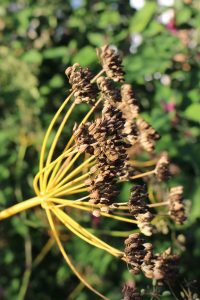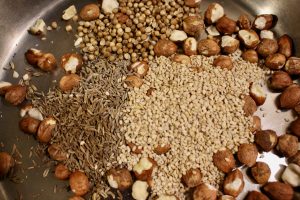Wild fennel: Foeniculum vulgare, Sweet fennel: Foeniculum vulgare var. dulce
Bronze fennel: Foeniculum vulgare ‘Purpureum’
Everyone knows fennel – it grows on roadsides and waste places, reaches 2m tall has feathery leaves and smells of aniseed. Some believe it poisonous, but actually it is very edible and delicious grown in a clean environment.
Right now in NZ in March the plants are flowering and attract many pollinating insects, ladybirds and flies – keeping them outside. It is a tall, perennial plant with pale yellow flowers in showy, festive umbels that look like umbrella ribs spreading from a central point. The flowers are followed by grey-brown seeds. I harvest them as they ripen.
Fennel originated in Southern Europe and the Mediterranean but it has naturalized in most temperate countries including NZ.
The ancient Egyptians used fennel as an eye remedy and the ancient Greeks used it to help with weight loss. It was in great demand during the Middle Ages (5th to 15th Centuries) by the rich who used fennel to flavour fish and
vegetable dishes, while the poor took it as an appetite suppressant on fasting days or to allay hunger.
The Romans liked eating the root, leaf and seeds in salads, and baking the seed in bread and cakes. Warriors took it to keep healthy and the Roman women took it to prevent obesity.
Fennel is still used to treat stomach problems, constipation, fevers, obesity, cramps and eye ailments. The leaves improve memory and are a general tonic for the brain.
I like to eat the swollen bulb of Florence fennel which I cut up finely in salads. I also use the feathery leaves in salad and in my smoothies. I add the seeds to my muesli for a nice aniseed taste, or make Dukkah spice.
Refreshing fennel Tea
Put 1 tsp fennel seed in a cup, add boiling water and steep for 5 minutes. Strain and drink to assist digestion or prevent heartburn and constipation.
For babies with colic give them a teaspoon full of the cooled tea.
For the eyes: soak a compress cloth in the tea and place on the eyelid to ease inflammation or watery eye, or let the solution cool and splash the tea into it.
Dukkah spice
This is a wonderful condiment found in Egyptian cuisine. It is delicious sprinkled on warm crusty bread, roast vegetables, salads, rice dishes, baked potatoes or pizza.
½ cup pine nuts, hazelnuts or walnuts
1 cup toasted almonds
1 tbsp coriander seeds, 1 tbsp cumin seeds, 1 tsp caraway seeds, 1 tsp fennel seeds
2 tbsp sesame seeds, 1 tsp dried thyme or mixed dried herbs
½ tsp sea salt
Put all the ingredients in a fry pan and on medium heat toast, stirring for about ten minutes. Don’t allow to burn. Allow to cool then place in a food processor and pulse carefully to break everything down but not
form a paste. It should be chunky and light. Store in a dry jar.
Enjoy!










